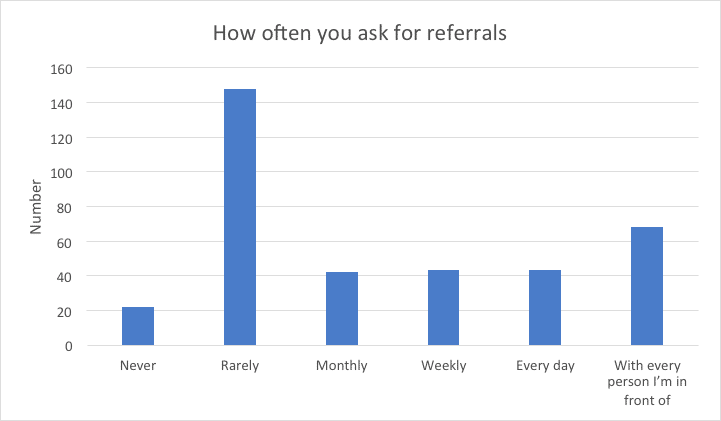Let me start with this quote, “If you don’t ask, the answer is always no” – Nora Roberts
Now let me explain…
Statistics from this survey help us really think about why we should be incorporating referral marketing into our strategies. 68% of consumers only left local businesses a review when asked, with 74% having been asked for their feedback. While the survey specifically looks at consumers and reviews, it is applicable to other areas as well: People are more likely to do something when asked.
Additionally, according to a sales study by Marc WayShack, 57.9% of salespeople said they ask for fewer than one referral per month, while 40.4% report rarely asking! Only 18.6% ask every customer they interact with.

You might have referral program banners, promotions, FAQs, email campaigns, and still struggle with getting people to refer. You might even have your customer support team promoting the referral program or other influencer marketing strategies. But they still might not ask, so why don’t people ask?
We’ve discussed some ways to ask for referrals here:
How to Ask for Referrals and Unlock Potential Sales
How to Write an Email Asking for a Referral or Recommendation
In the above articles, we’ve provided examples of what questions to ask and how to position yourself to maximize your conversion. However, it’s important to remember that asking for a referral can be defined as sales, opinions, marketing, and copywriting. And coming across too salesy can make or break your referrals. Therefore, learning how to integrate your questions with your brand style is vital.
It’s important to know how to ask questions, but more importantly, how to ask the right questions. To begin, let’s review the most basic questions that every salesperson would ask to get the sale, starting with your business itself.
Ask yourself these questions to come up with a strategy
Before you ask your customers for referrals, you need to know how to guide your conversation in your favor. Here are some questions to ask yourself:
- Who is the target market and when could they require your products?
- What forms of promotion have been effective/ineffective before and why?
- What are the best/worst forms of promotion that have been successful/unsuccessful?
- What promotion methods have your competitors used that you found successful/unsuccessful?
- What are the motivating and influencing factors that generate the most conversion?
Take a look at the first question. When interacting with a customer or potential customer, you might notice certain types of personas being revealed.
Maybe someone who decides based on incentives instead of the product itself needs more motivation or a referral reward to help make that decision. Understanding how they came to your site can help you tag these potential customers if they did not make a purchase even after they clicked on your promo ads.
Think about your product or service
Success is built upon and duplicated. Not all product or service features are going to be groundbreaking, but once you identify what drives the most conversion, run with it. Ask yourself:
- What are the current competitive products in the market and why?
- What type of services or products do your current customers prefer?
- What are the features your customers love the most and why?
- What objections have you had from previous customers?
- What inquiries are the most common?
- What challenges are your customers facing with your current product and how can you improve this issue?
Isolating key features and turning them into benefits helps people understand the intangibles.
Interesting word-of-mouth (WOM) referral example
Let’s take a look at Apple and how we can utilize their sales method to create more referrals.
Whenever Apple does a Keynote, they lure you with their features and benefits. They review the price and when the product will be available. If the product is available for pre-order or ready to purchase, word of mouth goes wild. Whether you’re a SaaS, eCommerce, b2b, or b2c, you most likely take the normal product updates strategy by posting it on your blog. Why not entice and incentivize your customers even more?
If you think about it, each product update or new product you might launch is a way to create customer loyalty and increase referrals. If the product is a one-off purchase, why not create a campaign that provides customers with a sneak peek?
Other possible strategies include:
- “Share this with others if you like this product!”
- “$49 one-time deal for our loyal customers”
- “Refer 3 friends and this can be yours for free.”
Ask yourself how your customers can benefit from your product or services and watch the number of opportunities to ask for referrals increase.
Increasing your odds for more referrals with your questions
Let’s take a look at a typical upsell pitch from McDonald’s: “Would you like fries with that?” This pitch made them successful, and they later integrated “Would you like to Super Size?” as well as others. However, if customers listen to the words carefully, you only have a 50/50 chance of getting an upsell. While 50/50 is still better than none, there are better ways to ask and increase your chances for the win.
On our first how to ask for referrals article, we mentioned the “foot in the door” method described by two Stanford researchers, Jonathan Freedman, and Scott Fraser. Having your customer say yes is important. Some people call it the power of persuasion, but I call it simple marketing.
You can do this several ways:
“Is there anyone else you know that might want the same level of service?”
Maybe your customer support provided amazing support, and the customer was wowed by your service. You might be able to hit a home run and have them agree to answer ‘yes’ to your question. But then you might also get a “no” or “maybe” response. Giving them the chance to say yes is great; creating value for your customers and meaningful reason goes beyond the 50/50 percentile. Let’s talk about these two different approaches and how you can optimize referrals.
Differentiating between close-ended and open-ended questions
Closed-ended questions can be answered by a simple “yes” or “no,” while open-ended questions require more thought and often more than one word to answer.
Open-ended questions can help customers really understand and think about something before they answer. If your customers says no, that eliminates a workaround or any room for opportunity. The advantage is that you can use their response and obtain more information that can help them agree to something. If you strongly believe that your customer will say yes, then open-ended questions are the way to go.
Create Value: How to use close-ended questions the right way
You can ask close-ended questions, but only if you can guide your customers to say yes. The “Xerox Copy” aka The Copy Machine study conducted by Harvard psychologist Ellen Langer looked at what would happen if someone was asked to cut in line at a busy Xerox store. They found that those who gave a reasoning behind their request (examples below) got their way 93% of the time, while those who gave no explanation only persuaded 60% successfully.
Here’s what happened:
- Version 1 (request only): “Excuse me, I have 5 pages. May I use the Xerox machine?”
- Version 2 (request with a real reason): “Excuse me, I have 5 pages. May I use the Xerox machine, because I’m in a rush?”
- Version 3 (request with a fake reason): “Excuse me, I have 5 pages. May I use the Xerox machine, because I have to make copies?”
The results for each version:
- Version 1: 60% of people let the researcher skip ahead in line.
- Version 2: 94% of people let the researcher skip ahead in line.
- Version 3: 93% of people let the researcher skip ahead in line.
Obviously, you won’t be providing any fake reasons, but it goes to show that creating value and reasoning will help you achieve success when asking for referrals.
Examples of closed-ended value questions
Here are a few examples of closed-ended questions you’ve probably heard before. By adding in value, you can increase your chances of getting the response you want.
- “Did I provide great service for you today?” If you want to lead with this, you might want to remind them what you’ve helped them with before asking the question.
- “Is there anything else I can help you with?” This might create an obstacle since the question is more geared towards ending the conversation.
- “Know any friends that you think would also want to save 30% like you just did?” Reminding them of what deal they got might provide a higher success rate.
Examples of open-ended questions
Building relationships is how you will increase your number of loyal advocates. Open-ended questions will help you develop that relationship faster.
“What prompted you to buy or seek our services in the first place?”
This is possibly the first question that goes through your mind when you think about a customer. What specifically made him/her choose your company over the other companies? Asking this question tells you how effective your marketing strategies were at conveying your message.
“What one or two things do you think we did better than our competitors?”
While asking this question, you are trying to illustrate what differentiates you from other businesses. This question tends to make it difficult to get specifics; a good business owner will try to get as much information from customers as possible.
“What could we do better to meet your desired experience?”
This question intends to assure the customer on our dedication to serving them and makes them feel like they are part of the decision making.
“Have you ever referred us to other people, and if so, why?”
This will measure how honest your customer is with you about the services you offer and whether or not they like your product.
“What are some rewards you think we should offer you for referring our business?”
Rewarding your customer for the good job he/she has done through incentives motivates them. Offering discounts might convince them to buy more from you at a better price and keep them from buying from competitors.
“What is the proper time for a referral program?”
Usually, the best time for a referral is immediately after a sale, especially during holidays and special offers. The business owner will find the best response at this time
“How important are social media platforms in referral programs?”
The power of social media is recognized as a driving force behind a successful business. This is because many customers are connected to the Internet so marketing campaign messages are channeled to them easily.
“What is the significance of a referral program?”
The business owner and customer should both know why referral programs exist in the first place. A clear understanding on both sides make the program much easier and successful. Asking this question can also help provide insight from customers that might tell you how they feel about a program and how you can make it better.
These questions will lead you in convincing your customer or a referee to join your referral program.
With the “foot in the door” method, convincing them to say yes is pivotal and leads to them agreeing to your second request: asking for referrals. The previously mentioned Stanford study showed that 52.8% of the people complied with the second request. By not using close-ended questions, you create a higher chance of customers agreeing to ask for referrals.
Best practices when asking for referrals
Here are a few more best practices for increasing your conversion rate when asking for referrals:
- Guide the conversation and be personable. Avoid speaking robotically, as you might sound when using a teleprompter. When using open-ended questions, you can adjust your request using the information they told you.
- Suggest solutions. Listening is a great way to make your customer feel welcomed and provide an experience they remember positively.
- Take action. You’ll never get what you want if you don’t ask. “With just three referrals, you can potentially receive all the products you’ve just purchased for free—know anyone?”
- Support them. Providing them the tools to go into the world and share information easily is a great way to get things up and running. People don’t want to do things, or if they agree to do it, they might procrastinate if the steps are too difficult. Understand and identify the quickest and effective way your customers can refer others.
Regardless of who you ask or what you’re marketing, using the general methods discussed is a sure-fire way to increase your odds and increase referrals and reap the benefits of referral marketing.



